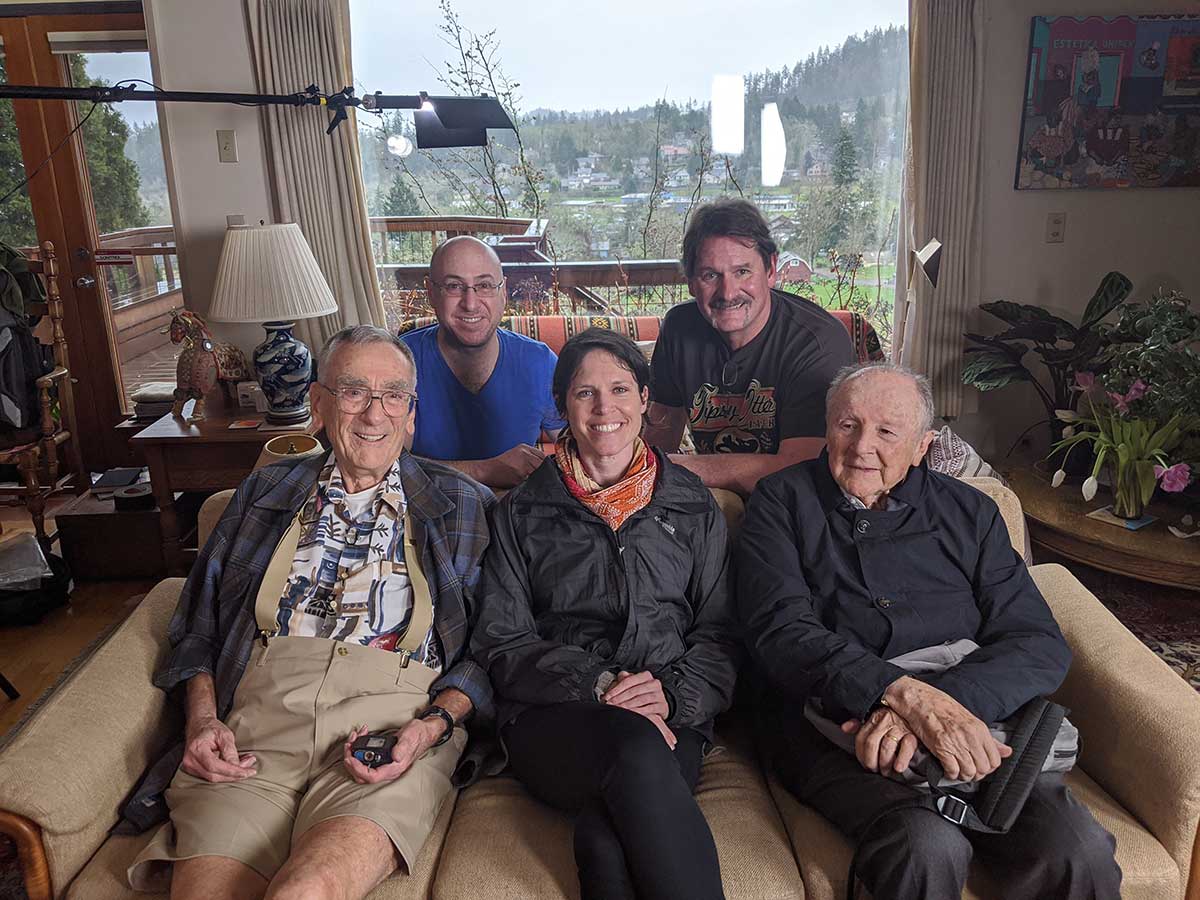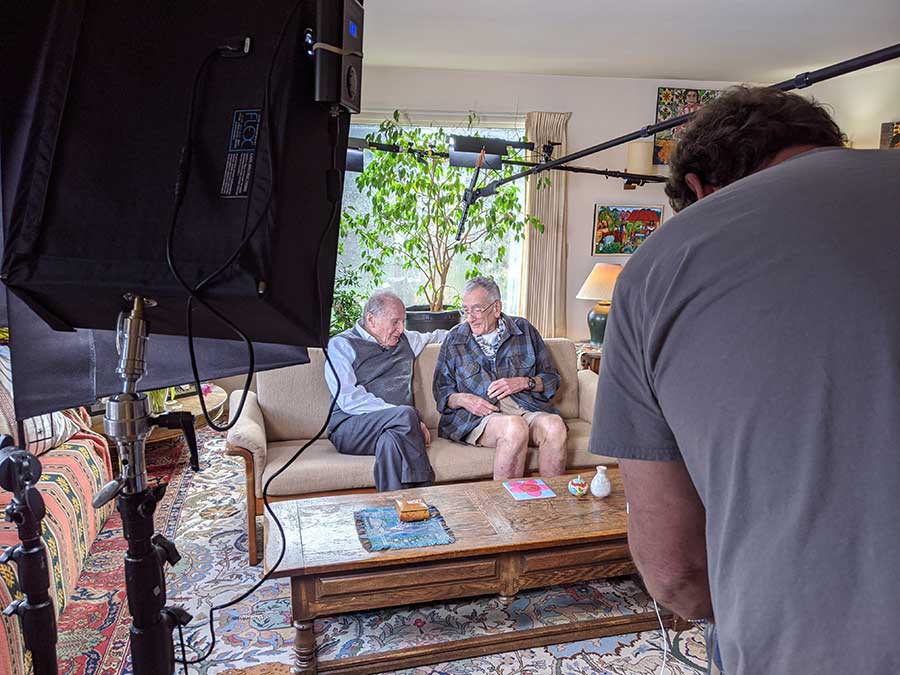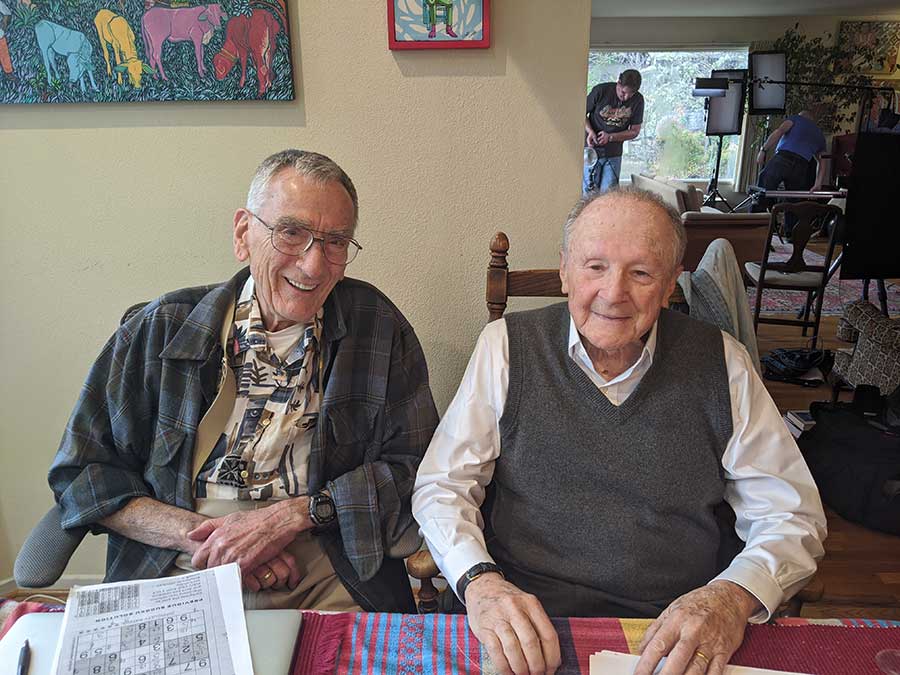
Back: Eric Kornblum, Derek Reich
In the early part of the year, we had an opportunity to get two world-renowned scientists together for a conversation about their discoveries, careers, and friendship. Matt Meselson and Frank Stahl performed what would become known as “the most beautiful experiment in biology,” which confirmed the semi-conservative model of DNA replication.
We’re really excited about our short film about Meselson and Stahl, which will premiere on our iBiology YouTube Channel on Wednesday, November 18 at 11am PST. As we wrap up the final finishing touches, we wanted to share a conversation with our own Brittany Anderton about her experience leading this project and getting to know these remarkable scientists.
How did this project come about?
This was something that had been in the works for a while. There was already a narrative in the Explorer’s Guide to Biology (XBio), which had beautiful graphics. We really wanted a video that highlighted their story, used these amazing visuals, and also shared the process of science. We had tried to get things together for this before, but Matt is in Boston and Frank is in Eugene, and they both have a lot going on, so figuring out the logistics of travel always gets complicated. We ended up having this window of time early in the year when everyone was available, so we had about 3 weeks to plan things out and get everyone where they needed to be. Amazingly, this all occurred about a month before cities on the west coast shut down from COVID-19.
How did you prepare yourself to interview them?
I remember learning about the experiment as a student, but I definitely had to do some refreshing. Fortunately, there are a lot of educational resources out there that address this experiment, even a few of our own. The iBiology explainer video is really helpful, as was our Discovery Talk video, and reading through the XBio narrative also provided a lot of context. In general, a lot of the educational resources out there are mostly text associated with a few illustrations.

The goal of this project was to create a video that both explained the experiment and portrayed the process and experience of science. We really wanted Matt and Frank to tell the story in their own words, so I tried my best to have them put us in their shoes. Or, their previous shoes. I wanted them to really think back about what was known at the time, what they were thinking, and how they communicated their findings with the world. They were in their 20s and they did an experiment that made them instantly famous in the world of science, I wanted to know what that felt like.
The personalities of these scientists come out a lot in the video, particularly their friendship with each other. Did you know about that before filming?
Not at all. The only hint of their personalities was from our discovery video, which only featured Matt and had a much different tone. I got the sense that they were nice from our pre-interview correspondence, but I had no idea that they were such delightful people. So warm and so friendly. I had this whole plan of how much time we would interview each of them separately and then together. But when we got them both on the couch talking in tandem, it was just so clear that we were getting great footage that illustrated their dynamism and friendship.

What was the most surprising or challenging part of this experience?
Honestly, one thing that surprised me was the ease of everything once I got there. I had done a lot of preparation, so that was definitely worth it. They are both so good at telling their story, and they really opened up over the course of the two days we were interviewing them. They were these icons of science to me before, but I really got a chance to get to know them as people.
In terms of challenges, there are always technical glitches that come up while filming, and we definitely had a few of those. The main thing was just figuring out the timing of the interviews and making sure we got every layer of the story – the personal, the technical, the experience. We wanted to have them reminiscing and telling jokes, but at the same time they had to explain density-dependent centrifugation on film. It’s a hard balance to strike, but I’m happy with what we got.





Aavash Adhikari says
thank u so much for this effort.
David Bear says
From 1978 to 1982, I was a postdoctoral fellow at the University of Oregon Institute of Molecular Biology where Frank Stahl was a professor. I sat in on his genetic recombination course and we would sometimes play basketball together (he was a rabid Oregon Ducks fan and I was a UCLA fan). Frank wrote a one-sentence letter of recommendation for me to attend the Cold Spring Harbor Bacterial Genetics Course that said, “Let him in.” Frank and his wife Mary hosted a baby shower for a postdoctoral fellow in the lab and my wife and I were invited. Unfortunately, the night of the shower coincided with the UCLA-Oregon basketball game, and I was heartbroken that I would have to miss the game to attend the shower. In the middle of the gift unwrapping, Frank whispered in my ear, “Do you want to go downstairs and play pool and listen to the game?” It was a night I will never forget, even though my wife really chewed me out when we got home.